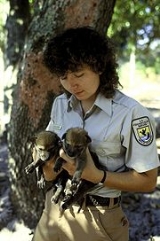
Captive breeding
Overview
Captive breeding
is the process of breeding animals in human controlled environments with restricted settings, such as wildlife reserves, zoo
s and other conservation
facilities; sometimes the process is construed to include release of individual organism
s to the wild, when there is sufficient natural habitat
to support new individuals or when the threat to the species
in the wild is lessened.
Captive breeding has been used with success for some species for some time, with probably the oldest known instances of captive breeding being attributed to menageries of European and Asian rulers, a case in point being the Pere David's Deer
.
is the process of breeding animals in human controlled environments with restricted settings, such as wildlife reserves, zoo
Zoo
A zoological garden, zoological park, menagerie, or zoo is a facility in which animals are confined within enclosures, displayed to the public, and in which they may also be bred....
s and other conservation
Conservation biology
Conservation biology is the scientific study of the nature and status of Earth's biodiversity with the aim of protecting species, their habitats, and ecosystems from excessive rates of extinction...
facilities; sometimes the process is construed to include release of individual organism
Organism
In biology, an organism is any contiguous living system . In at least some form, all organisms are capable of response to stimuli, reproduction, growth and development, and maintenance of homoeostasis as a stable whole.An organism may either be unicellular or, as in the case of humans, comprise...
s to the wild, when there is sufficient natural habitat
Habitat
* Habitat , a place where a species lives and grows*Human habitat, a place where humans live, work or play** Space habitat, a space station intended as a permanent settlement...
to support new individuals or when the threat to the species
Species
In biology, a species is one of the basic units of biological classification and a taxonomic rank. A species is often defined as a group of organisms capable of interbreeding and producing fertile offspring. While in many cases this definition is adequate, more precise or differing measures are...
in the wild is lessened.
Captive breeding has been used with success for some species for some time, with probably the oldest known instances of captive breeding being attributed to menageries of European and Asian rulers, a case in point being the Pere David's Deer
Père David's Deer
Père David's Deer, Elaphurus davidianus, also known as the Milu , is a species of deer known only in captivity. It prefers marshland, and is believed to be native to the subtropics of China. It grazes on a mixture of grass and water plants. It is the only extant member of the genus Elaphurus...
.

